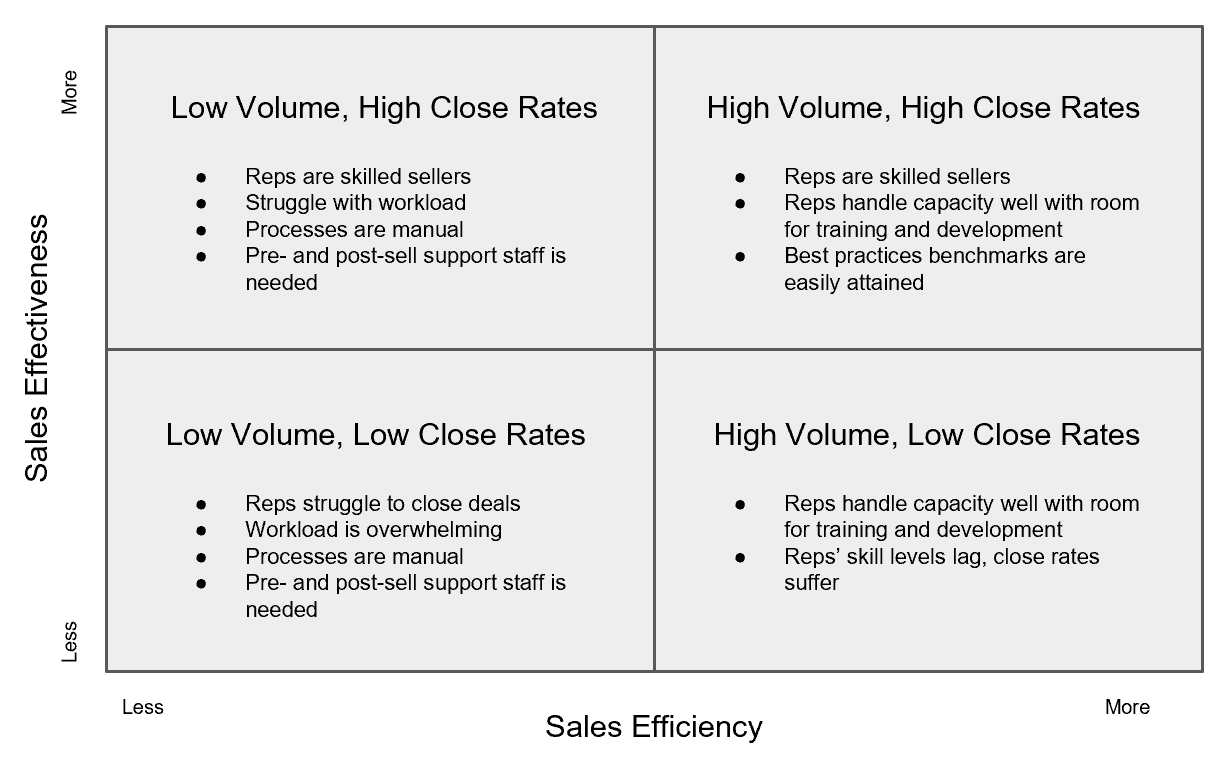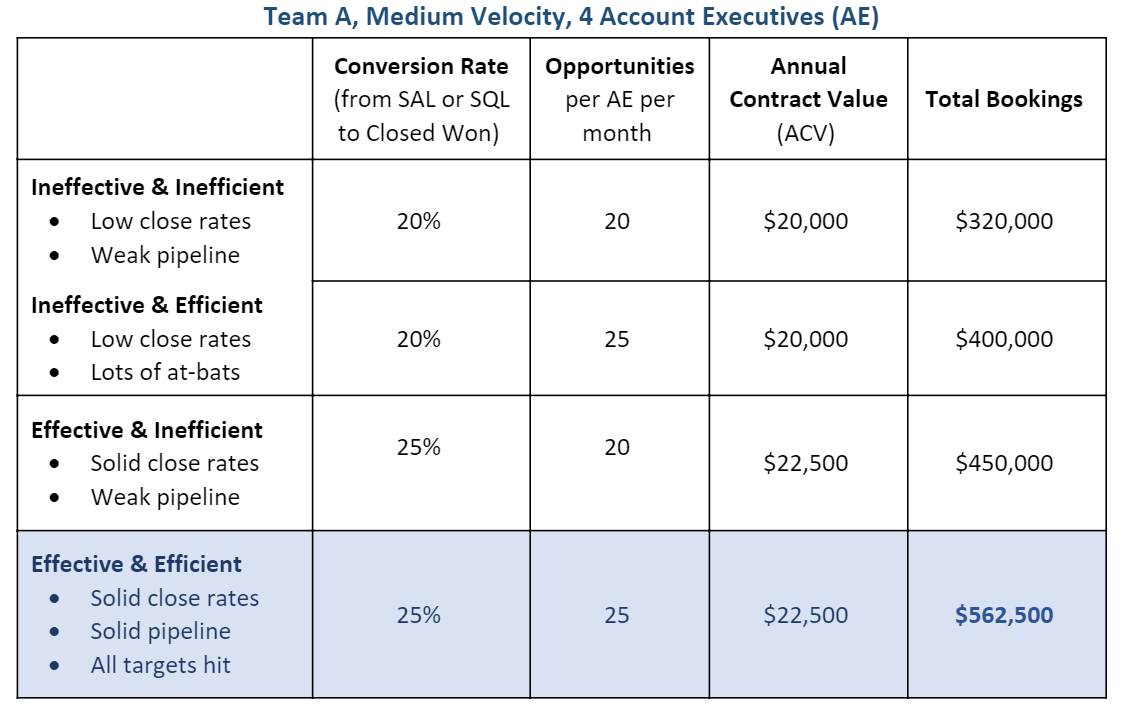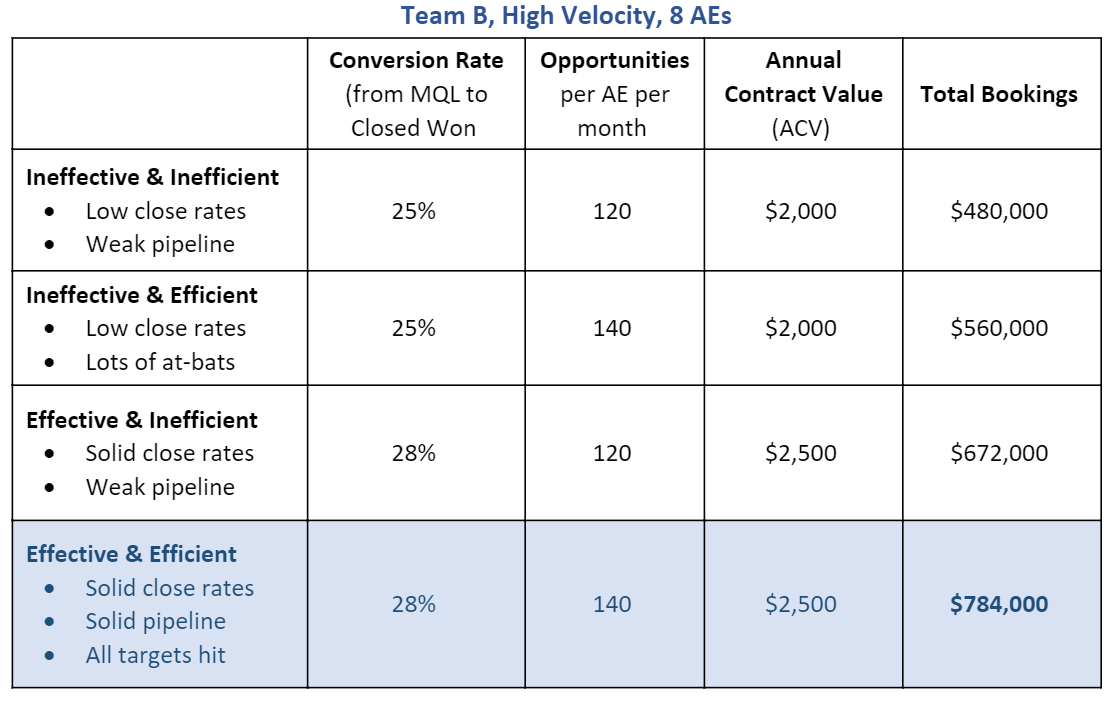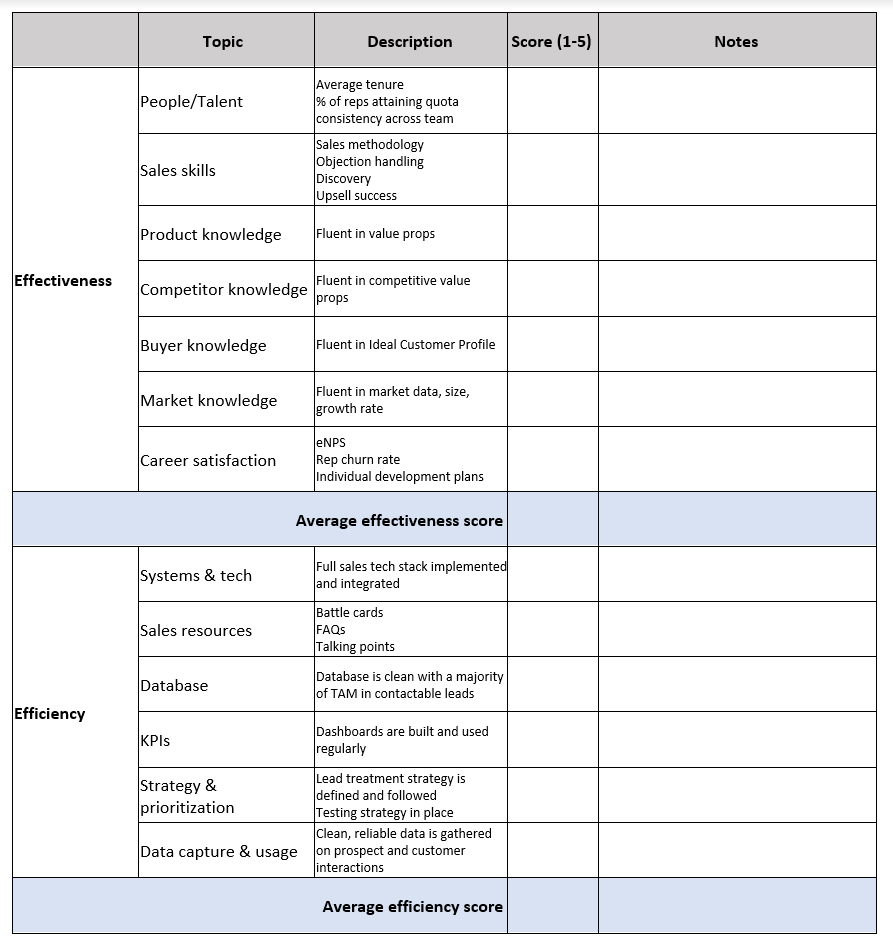How to Improve Sales Effectiveness and Efficiency
Now that you’ve built your 2021 budget and completed your sales kickoff, you need your sales team to start delivering successfully. Success doesn’t happen on accident—you need to enable it. Where do you start?
There are two primary areas you should focus on: your sales team’s effectiveness and efficiency.
When you have highly effective reps working in an inefficient environment, your reps may become frustrated and be more likely to leave. When you have ineffective reps working in an efficient environment, their limited skills won’t engage with prospects to close deals. When your reps are both ineffective and inefficient, you will likely fail.
However, having a sales team that is both effective and efficient can create a multiplicative impact on bookings. A 2-by-2 showing combinations of sales efficiency and sales effectiveness might look like this:


What is Sales Effectiveness?
- Sales skills. How well do your sellers navigate conversations with your prospects? This includes discovery, pain funneling, objection handling, closing, fulfillment, relationship management and prospecting.
- Product knowledge. How fluent are your sellers in your product? Does it require a sales engineer to demo your product?
- Competitors, buyers and markets. How fluent are your sellers in their competition, the buyers you serve and the markets you focus on?
- Career satisfaction. This includes career pathing and professional development, team mission and values, and team culture.
What is Sales Efficiency?
- Systems and tech. Do you have the right tools in place to support the team and to automate most/all of their manual tasks?
- Data capture. Are you capturing data on every interaction that is clean, reliable and in a reportable format?
- Strategy and prioritization. Do you have a clear view on how to prioritize leads and opportunities for your teams? Does your team understand and follow a specific lead treatment strategy?
- Resources. Is your team armed with the right sales resources, such as FAQs, talking points, competitive battle cards, etc.?
- KPIs. Do you have a dashboard to track the most important performance data at the team and individual levels? Do you have strong visibility into your team’s performance and your funnel?
- Database. Does your marketing database have a large percentage of your total addressable market in clean and contactable records?
Should you Focus More on Sales Effectiveness or Efficiency?
The emphasis you place on improving sales effectiveness versus sales efficiency will vary based on the type of sales cycle you have and the size of deal you sell.
For example, a low velocity, high-touch, long sales cycle needs highly effective sellers. Yes, an efficient system is beneficial, but you can sacrifice efficiency if your reps are working a handful of strong opportunities at a time within a six- to 12-month sales cycle.
On the other hand, a high-velocity, transactional sales cycle needs a highly efficient team. Yes, effective sellers will increase your conversion rates and the size of your deals via upselling, but it’s important to know (based on your buyers, deal size and sales cycle) where to focus your reps’ energy.
Let’s look at two examples. Team A has a mid-velocity sales model (longer sales cycle and fewer total opportunities worked by their AEs at one time). Team B has a high-velocity sales model (shorter sales cycle, more leads and opportunities worked by AEs at one time).




From these examples, it’s easy to see the multiplicative effects of having both effective and efficient teams.
It’s important, then, to diagnose the gaps in your current system and to create a plan that you deliver over time to close them and help the team become both more effective and more efficient.
Any focused effort that improves effectiveness or efficiency will improve bookings so if you don’t know exactly where to start—just start! Work to make your team more effective and more efficient in any way you can.
Four Steps to Making your Sales Team Efficient and Effective
- Evaluate your funnel. Where do you see friction in your sales stages? Where do the most deals fall out of your funnel? How consistent is your funnel data across reps on your team? By first analyzing your funnel, you begin to identify problem areas.
- Analyze your existing systems, sales processes, pipeline stages and training programs. What do you have? Where do you see friction? Where do you get the most feedback from reps? What doesn’t exist?
- Evaluate your teams on their performance (funnel metrics) and the ecosystem they work within (the sales process you built and the support they receive). Where are you strong? Weak? How consistent are your reps? Where do most inconsistencies exist? Consider engaging with a third party to complete this evaluation. They will be objective and offer fresh methodology. To evaluate your team, try using a simple scorecard. View a sample scorecard at the bottom of this post.
- Create a project plan and prioritize your projects, putting the most burning needs first. You’ve identified the gaps, now close them. One at a time.
For long-term changes, be patient and methodical
Remember that everything you change for your reps will need time to sink in. You cannot throw a bevy of new processes and training sessions at them and assume it will all stick, especially not right away. Be thoughtful about the changes you make and sequence them properly to empower your reps to become as efficient and effective as possible.
Below is the sample scorecard. You can customize it and add complexity as needed.


Certain information contained herein constitutes “forward-looking statements,” which can be identified by the use of terms such as “may,” “will,” “should,” “could,” “would,” “predicts,” “potential,” “continue,” “expects,” “anticipates,” “projects,” “future,” “targets,” “intends,” “plans,” “believes,” “estimates” (or the negatives thereof) or other variations thereon or comparable terminology. Forward looking statements are subject to a number of risks and uncertainties, which are beyond the control of Mainsail. Actual results, performance, prospects or opportunities could differ materially from those expressed in or implied by the forward-looking statements. Additional risks of which Mainsail is not currently aware also could cause actual results to differ. In light of these risks, uncertainties and assumptions, you should not place undue reliance on any forward-looking statements. The forward-looking events discussed in this content piece may not occur. Mainsail undertakes no obligation to update or revise any forward-looking statements, whether as a result of new information, future events or otherwise.
No representation, warranty or undertaking, express or implied, is given as to the accuracy or completeness of the information or opinions contained in the enclosed materials by Mainsail and no liability is accepted by such persons for the accuracy or completeness of any such information or opinions. For additional important disclosures, please click here.

